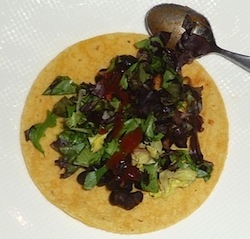Cooking Climate-Friendly without a World-Class Chef

A few weeks ago I had the privilege to participate, along with chef Spike Gjerde of Baltimore’s famed Woodberry Kitchen, in development of a radio piece for American Public Media’s Marketplace. The story, by reporter Jon Miller, was the conclusion of his Food for 9 Billion series discussing how we could sustainably feed a planet with 9 billion people on it. Our assignment was to shop for, prepare (okay, Spike and his colleague Ben Lambert did the preparing), and eat a climate-friendly holiday meal, chatting all the while. The story aired on December 17, along with my culled-down list of four tips for climate-friendly eating and my blogpost. I was pleased with the story and glad that the message came through that while there are powerful reasons for changing our individual dietary behavior, that’s not enough—we have to work for change at the government and business levels.
The meal I had that night was certainly one of the finest I’ve eaten. Yet, if it takes a professional chef to cook climate-friendly, we’re all doomed. I wanted to write one more blogpost to talk about that.
Does it have to cost more to eat climate-friendly?
No. I had summarized four main steps a person should take to eat in a more climate-friendly way. Take a look:
- Eat less meat: saves money
- Waste less: saves money
- Save energy: saves money
- Support the local and sustainable food systems we’ll need as the climate situation worsens: maybe.
So we save money on 1, 2, and 3. Could we ever come out even on 4?
You will find that in-season items at many farmers markets are priced comparably to or even lower than the same items at the same time in the supermarket. But the reality is that it usually does cost more to produce sustainable and local foods and get them to us, both because of the extra costs to make them environmentally sustainable and the more hands-on nature of the work—and also because the playing field is not level. Most of the foods you buy in the supermarket benefit from a host of price savings, from availability of distribution infrastructure to ability to avoid paying the costs of their environmental damage. If you bought the foods at Walmart, the company also passed off their employee health care costs to the public.
What if we as a society committed to leveling the playing field? We could, for one, enforce existing environmental laws. And we could pass a farm bill (what a novel idea!) that includes strong investments in distribution networks for local and regional foods; in conservation incentives; in support for beginning and socially disadvantaged farmers; in research and development for sustainable production; and one that flips the incentives that preferentially support industrial food production. Of course, even our best efforts to level the playing field might not fully equalize costs, but we could bring them closer together. The converging crises of climate change, soil depletion, peak oil, peak phosphorus, water depletion and population growth all mean that our future food security DEPENDS on transitioning to a more resilient food system. So there is an urgent need to shift policies so it is a lot easier for most people to afford to align their shopping with the demands of a changing world. (And get great food in the process).

In the meantime, those who find buying local and sustainable through the winter out of reach can still make a huge impact by eating less meat, reducing waste, and looking at their food-related energy use. Greenhouse gas-wise, canned or even frozen vegetables are still better than red meat.
And I didn’t mention it in the show, but growing your own is a great way to make food fresh, delicious, as local as can be, sustainable and affordable. I’m a gardening fanatic, and I know it’s never as easy as some would have us think—you put seeds in the ground and come back a few months later to a bounty harvest—but the whole process of gardening is immensely satisfying. The next step down that path for me is preserving the foods from my garden and farmers market/Community Supported Agriculture program. For a small investment in equipment and time, I can get local, sustainable and affordable all winter long.
Why can’t Spike Gjerde cook for me every day?
So, it’s clear that climate-friendly eating can be wallet friendly—and would be more so if we shifted our policies to match our reality. But is it easy too? That was one fine meal I ate with Spike. And I would be in trouble if I didn’t note for the record that my husband, who cooks most of our meals, is also quite talented. But for those like me who don’t adore cooking, or who court disaster if we digress from a recipe, there is still hope. Hopefully Spike will write up the recipes for what he made for us that night. Even if he doesn’t, websites and cookbooks have proliferated with quick, easy, great-tasting, and affordable climate-friendly recipes and food selection guides. Here are just a few: So get out there and give it a try! (And keep pushing for higher-level action while you’re at it!)
Some climate-friendly recipes and guides: